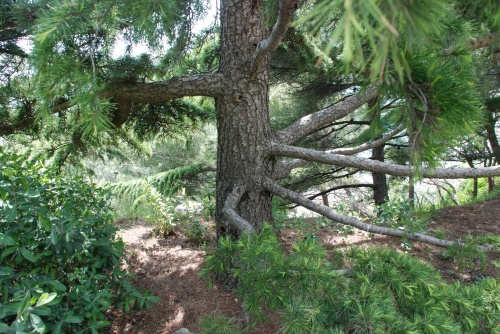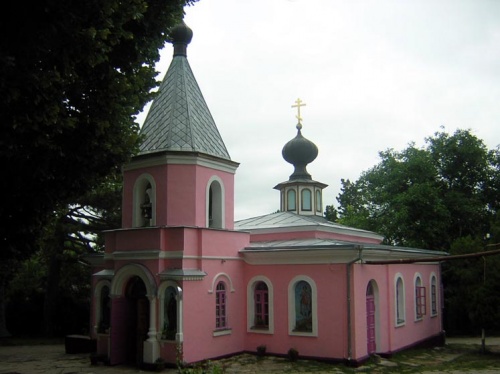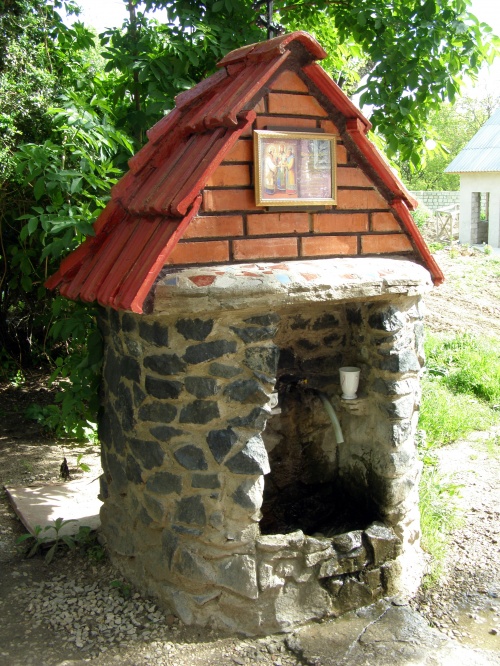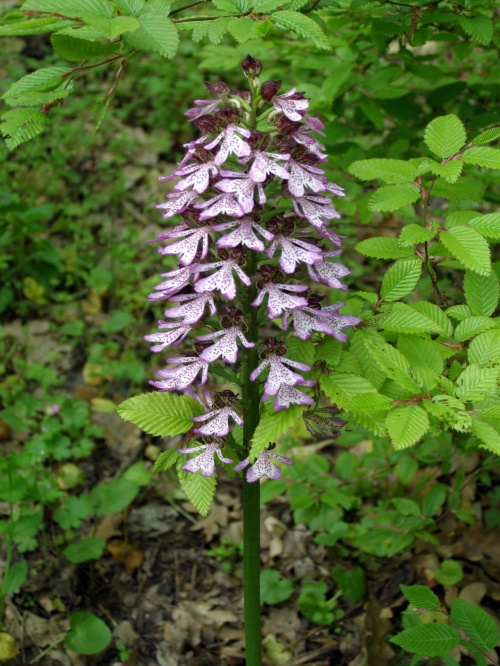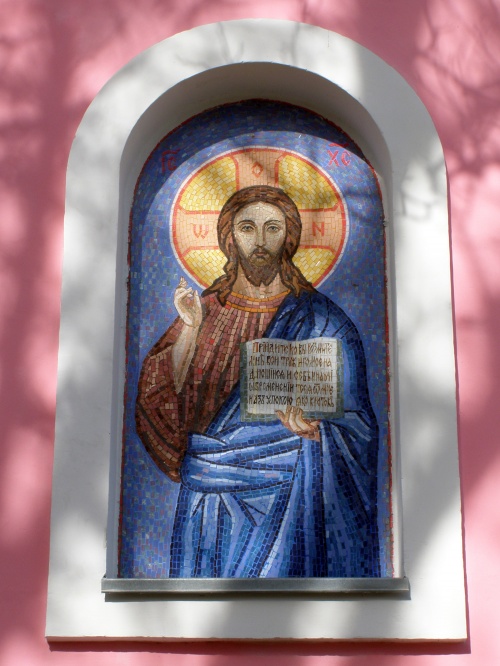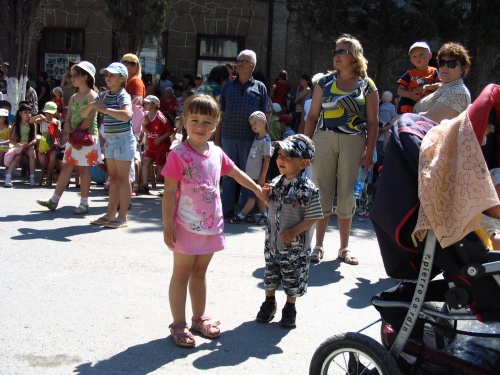Sightseeing photo tour: South-East of Crimea (76 photos) (part 1)
Разрешение картинок от 450x532px до 3872x2592px
Three weeks ago I had the pleasure of visiting Crimea, in its southeastern part. Lots of impressions. Of course, it’s such a blessing to escape into the real world, even for a few days, away from boring friends-3 computers and the bottomless depths of the Internet.
Remember, our uncle Kolya announced that he was leaving with his family for the summer in Crimea? Circumstances so happened that my trip was to those parts. So we decided to join forces and highlight through a photo excursion the places that each of us has visited in one way or another laughing
1. Novotroitsky Praskevievsky Toplovsky Convent
Crimea is filled with legends. You especially feel this when you approach the Toplovsky Monastery. Here, according to legend, the Venerable Martyr Paraskeva Friday was executed. To get to the monastery you need to climb for a long time along a dusty, steep, snaking road, around which unusually tall, fabulous trees stood like a thick wall in the calm, without moving. The monastery amazes with its light, openwork beauty, clear, sonorous air, picturesque hills and paths. Involuntarily, a person is overcome by a slight euphoria (as it should be in the highlands).
I saw a squirrel right near the church, what a healthy one it was, well-fed lol
The holiness and grace of the place is felt immediately. We didn’t see many tourists, although we spent 5 hours on the territory of the monastery. In total we walked 15 km...
And Saint Paraskeva heals everyone here. The saint was born in Rome in the 2nd century. Her Christian parents did not have children for a long time and through their prayers they asked the Lord for their only child - a daughter, who was named Paraskeva in honor of her birthday - Friday in Greek. After the death of her parents, having distributed property to the poor, Paraskeva left the world and devoted herself to preaching the Gospel of Christ to the pagan peoples. In Rome, the center of paganism and pagan education, she was honored to endure her first suffering for the name of Christ and converted many pagans to the Christian faith.
Emperor Antonin ordered Paraskeva to be put to torture: a red-hot copper helmet was placed on her head, and she herself was thrown into a cauldron filled with boiling resin and oil, but the saint remained unharmed. The king doubted whether the resin and oil were really hot, and ordered Paraskeva to splash the molten liquid on him. The saint splashed her hand; The king instantly became blind from terrible pain. Then he prayed to the saint: “Servant of the true God, have mercy on me and return light to my eyes, so that I can believe in the God whom you preach!” The saint enlightened the king and those with him with the teachings of the Christian faith, was released in peace and went to preach the teachings of Christ to other countries. In the city where a certain Tarasius reigned, for preaching the gospel of Christ, the king gave her over to many terrible torments. Seeing that nothing could turn the saint away from her faith in Christ, Tarasius ordered her honest head to be cut off. Thus Saint Paraskeva sealed her apostolic labors with martyrdom for the name of Christ.
I took a special photo of these dandelions for Andryukha lol
There was a spring at the execution site. The same one to which many suffering and ailing people go. A chapel was built above the source of St. Paraskeva, the waters of which, according to believers, heal the eyes. Nearby is a round bathhouse, the pool of which receives water from other monastery sources. One and a half kilometers from the monastery there is a spring named after St. George the Victorious. Its waters are believed to have healing properties for those suffering from rheumatism. Source captured. There are baths for pilgrims (pink for women, blue for men).
Another three kilometers higher along the beam, under an iron cover, there is a massive concrete catchment with three water outlets. This is the source of the Three Saints - Basil the Great, Gregory the Theologian and John Chrysostom. Its waters are believed to cure nervous diseases. At the very top of the ravine, a noisy waterfall falls from a high sloping slope, at the base of which there is a metal cross. You can take a bath in a natural bath formed by the force of falling water. For ease of descent, steps have been cut into the steep slope of the valley. But I didn’t get there anymore, I didn’t have enough strength wink
2. Pike perch. Genoese fortress.
Everyone who comes to Sudak goes to see the Genoese fortress. By the way, we lived right at the foot of the fortress in a small boarding house. The guides talk about it in detail, and everything they tell is difficult to remember, so many people lived in the fortress at different times. But even if you don’t know all the dates and events, the fortress is worth seeing: in fact, the fortress is made up of high battlemented walls that stretch along the hill, so that one wall is just above the sea. When you stand under the walls, it’s as if you’re seeing a piece of Italy in Crimea. The founders of the fortress were Alans (ancestors of the Karachais and Balkars); later the fortress belonged to the Khazars, Polovtsy, Seljuk Turks, and Mongols (they destroyed the walls, because for a Mongol it is a shame to hide behind walls). In 1270, the fortress was occupied by the Venetians, and from 1365 the entire Black Sea coast passed to the Genoese. Enterprising people from Genoa paid taxes to the Mongols and, as it were,
shore for rent. Trade flourished, the fortress had its own workshops, a clay water supply system and a single garden near the consul’s house. The consul arrived in Crimea and lived here for one year, “locked up” (for security reasons, he was not allowed to leave the fortress). Photos of me and Nikolai
The two-story consul tower stands on the very cliff. They say that from the tower there was a secret passage down to the port, so that in the event of an attack the consul could reach the ship. To this day, slabs with Genoese coats of arms have been preserved on the towers. True, there are no houses inside the walls, only the wind rolls the steppe grasses.
Every year the fortress hosts a knight's tournament, which usually lasts a week. What's going on around here! Just like in the Middle Ages, there is a crowd of people (some in fancy outfits), someone has set up his stall right in front of the gate and is briskly selling pasties and beer. The only thing missing is the horsemen who leisurely ride into the city. Inside the fortress, everything is as it should be: they fight with swords, shoot from a cannon, choose the most beautiful costume. You can even make something out of clay in pottery workshops. Some hippies are hanging out in the heat, children are scurrying around underfoot, everyone is making noise, getting lost and finding each other again in the crowd. No give or take, Genoa, XIV century.
The walls with battlements at the top that we see now are a restoration from the 1960s (in 1927 there was a big earthquake and part of the walls collapsed). I don’t know why the Genoese fortress is so attractive, it’s kind of thoughtful. Is it standing above the sea and how long will it last?
But, besides the fortress, there is also the city of Sudak, with an embankment, sanatoriums, streets, courtyards and inscriptions: “housing for rent”, “housing by the sea”, “set meals”, etc. tongue
The city's population is 18 thousand inhabitants. The foundation of Sudak dates back to 212, the ancient name is Surozh, Sugdeya, Soldaya. After the Genoese captured Sudak in 1365, it became the center of world trade routes. The famous “Silk Road” ran through it.
This is Koka, the grandson of Nikolai Nikolaevich
Nikolay's information for the photographs is as follows: There is almost no one on the beaches now. Air temperature 22, water temperature – 17, dry. The ruble/hryvnia exchange rate is 10/2.40. The local authorities set the opening of the season for June 10, by this date the beaches should be equipped and all summer establishments should be open (Coke on the 10th, 2 years 9 months, will be just the place to celebrate). Work is in full swing, and some things are already working. This year many “wild” vacationers and guests are expected; health resorts with “organized” vacationers are already filled.
Sudak is the birthplace of Russian champagne and many other famous Crimean wines. Special grape varieties ripen on the mountain slopes, the wines from which, such as “Black Doctor”, “Black Colonel” and many others, are famous throughout the country. I bought 7 bottles of wine and brought them all home. They drank and praised me for not forgetting anyone
3. Old Crimea, the source of St. Panteleimon, ruins of mosques
The next day after the trip to Sudak, we went to Old Crimea. Located half an hour's drive from Feodosia, the small village was once a prosperous city, the headquarters of the Tatar governor of Crimea, in the 13th-14th centuries. The Tatars called it Kyrym, and the Genoese called it Solkhat (there is a version that the city consisted of two parts, which bore these names).
These ruins are all that remains of the ancient mosque. It is called the Baybars Mosque.
A native of Crimea, Baybars was sold into slavery in Egypt, where he became first a Mamluk, and then one of the greatest sultans of Egypt. He went down in history with his victory over the Mongols, which stopped their advance in the Middle East. In 1287, he allocated two thousand dinars for the construction of a mosque in his homeland. And in 1287-1288 a mosque was built in Solkhat, which became the first mosque in Crimea. True, at one time there were several mosques in Solkhat that claimed this name, but of all of them only this one remained, which “due to the retirement of rivals” is considered the Baybars mosque. But the Uzbek Mosque, built in 1314 by order of the Golden Horde Khan, has been preserved much better.
Adjacent to the mosque from the south are the ruins of a madrasah, also built in the 14th century.
And these are the ruins of the Kurshum-Jami mosque or the Lead mosque. It got its name because craftsmen filled the gaps between the stones with lead for strength.
Then we headed to the source of St. Panteleimon, and on the way we saw this funny house with a peacock.
In general, Old Crimea is quite strongly connected with literature. Konstantin Paustovsky, Alexander Green, Yulia Drunina, Alexey Kapler (the same “Kapler who suffered from Stalin”) lived in it. The last three are buried in the local cemetery. Unfortunately, we did not have time to get to either the Green house museum or the Paustovsky house museum.
Scarlet sails are reminiscent of Alexander Greene.
The source itself is covered with a cap so that garbage is not thrown into it... and water flows from it through a pipe, and a small swimming pool was built on the territory for those who want to plunge into the healing water
There is a chapel nearby.
She has wonderful instructions on baptism techniques hanging on her door.
4. Aivazovsky Museum (Feodosia). Koktebel.
On the alley there were many posts dedicated to the work of Aivazovsky,
So I won’t go into too much detail. We were forbidden to take photographs at the museum. Therefore, I only took photos of the outside and bought an album, scans from which I uploaded into a separate archive for you. The works are not exactly what everyone hears: wink
1. Alushta 1870s
2.Seashore 1886
3.Seashore at night near the lighthouse 1837
4. Storm in the ocean 1864
5.Sunrise 1870s
6. Group of clouds 1889
7.Dante and the artist in the mountains 1883
8.Caucasus Mountains from the sea 1899
9. Reeds on the Dnieper near the town of Aleshki 1857
10.Crimean landscape 1859
11.On the island of Crete 1867
12.Niagara Falls 1893
13.Ischia Island near Naples 1892
14.Island of Rhodes 1861
15.Quiet Sea 1893
16. Foggy morning in Italy 1864
17.Morning on the shore of the bay 1853
18.Feodosia 1875
19.Calm off the Crimean coast 1899
Under the museum wall, local artisan artists sell their work
We were brought to Koktebel-Cognac Country for a short time. Stock up on cognac and wine at the company store lol
“...The concentration and tightness of the jagged rocks,
And nearby is the breadth of the steppe plains and the dying distances
The verse has a running start, and thoughts have been given a measure.
My dream has been filled with water since then
Foothills heroic dreams
And Koktebel has a stone mane;
Its wormwood is intoxicated with my melancholy,
My verse sings in the waves of its tide
And on the rock that closed the swell of the bay,
My profile is sculpted by fate and the winds.”
Maximilian Voloshin
5. Path, Golitsin Grotto (New World)
"Paradise" - "New World" is located 6 km west of Sudak. The road to it goes near the sea, along a steep slope skirting the foot of the Kush-Kaya rock, in Russian “Falcon Mountain”. The area now occupied by the plant was called “Paradise” during the Greco-Byzantine and Genoese periods in the history of Crimea. “Paradeisos” from ancient Greek meant garden, park, and in poetic works – paradise.
Indeed, this is an extremely picturesque corner. The mountains, covered with pine and juniper forests, came here like an amphitheater close to the sea and with their two protrusions, Sokol Mountain from the east and Karaul Mountain, both from the west, formed a beautiful and cozy bay with a unique microclimate.
1878 - Lev Sergeevich Golitsyn comes to the New World for the first time.
The history of ancient Surozh (Pike perch) was well known to him, but the bay in the New World especially struck the 33-year-old prince with its beauty, and he gave it both his family wealth and his life. This wild and free corner of Crimea was the embodiment of the Golitsyn character itself.
In September 1878, the first batch of Bordeaux wine was made, and experiments began on the production of sparkling wine using the champagne method. It was on the Novy Svet estate that the will and thought of the great Russian winemaker in organizing champagne production most clearly manifested itself. The “New World” estate was the most important line in the life of Lev Sergeevich Golitsyn, it was his brainchild and the crown of all creative searches in winemaking.
L.S. Golitsyn never made a profit from his wine. He kept the best brands of wine for his guests and friends, to whom he gave wine in large quantities. In addition to creating his own wines, the prince spent a lot of money buying the best wines from other brands. Along with his passion for wine, the prince coexisted with the passion of a collector of literature and art objects. He created an extensive library in the "New World".
Living on a grand scale could not but affect the prince’s financial situation. But Golitsyn was seriously concerned about the fate of his favorite brainchild: wine cellars in the New World. The prince asked for an audience with Emperor Nicholas II, making the following request: “Sir, I am old, it’s time to think about the future, about approaching death. I have to get my affairs in order. I have an illegitimate child. Please accept it, Sir! Do it". The Emperor looked at him in surprise: “Listen, Prince, what are you saying?” - “This is an illegitimate child, Sovereign, my property is the “New World” estate with its cellars. You are the only one, Sovereign, to whom, when I die, I can leave my brainchild. Please accept it."










